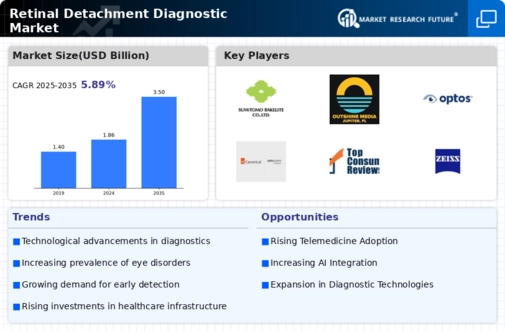Government Initiatives and Funding
Government initiatives aimed at improving healthcare infrastructure and funding for eye care services are pivotal for the Global Retinal Detachment Diagnostic Market Industry. Many countries are investing in healthcare programs that prioritize eye health, recognizing the economic burden of untreated eye conditions. These initiatives often include funding for advanced diagnostic technologies and training for healthcare professionals. As governments allocate resources to enhance eye care services, the market is likely to benefit from increased accessibility and affordability of diagnostic services, fostering growth in the coming years.
Growth of the Geriatric Population
The aging population is a significant driver of the Global Retinal Detachment Diagnostic Market Industry. As life expectancy increases, the number of elderly individuals susceptible to retinal disorders rises correspondingly. This demographic shift necessitates enhanced diagnostic services to address the unique healthcare needs of older adults. The market is poised for expansion as healthcare providers adapt to this growing population segment, which is expected to contribute to the market reaching a valuation of 3.5 USD Billion by 2035. The focus on geriatric eye care will likely shape future diagnostic strategies.
Increasing Prevalence of Eye Disorders
The Global Retinal Detachment Diagnostic Market Industry is witnessing growth due to the rising incidence of eye disorders, particularly retinal detachment. As populations age, the likelihood of developing conditions such as diabetic retinopathy and age-related macular degeneration increases. According to health statistics, the prevalence of these disorders is projected to rise, leading to a greater demand for diagnostic services. This trend is expected to drive the market value to approximately 1.86 USD Billion in 2024, as healthcare systems adapt to meet the needs of an aging demographic and improve patient outcomes.
Rising Awareness and Screening Programs
Increased awareness about eye health and the importance of regular screenings is contributing to the growth of the Global Retinal Detachment Diagnostic Market Industry. Public health initiatives and campaigns aimed at educating individuals about the risks associated with retinal detachment are encouraging more people to seek timely medical attention. This proactive approach is likely to result in higher diagnostic rates, thereby increasing market demand. As awareness continues to rise, it is anticipated that the market will experience a compound annual growth rate (CAGR) of 5.92% from 2025 to 2035, reflecting a growing commitment to eye health.
Technological Advancements in Diagnostic Tools
Advancements in technology are significantly influencing the Global Retinal Detachment Diagnostic Market Industry. Innovations such as optical coherence tomography (OCT) and fundus photography have enhanced the accuracy and efficiency of retinal diagnostics. These technologies allow for earlier detection and better management of retinal detachment, which is crucial for preserving vision. The integration of artificial intelligence in diagnostic tools is also emerging, potentially improving diagnostic precision. As these technologies become more widely adopted, the market is expected to grow, with projections indicating a value of 3.5 USD Billion by 2035.
























Leave a Comment